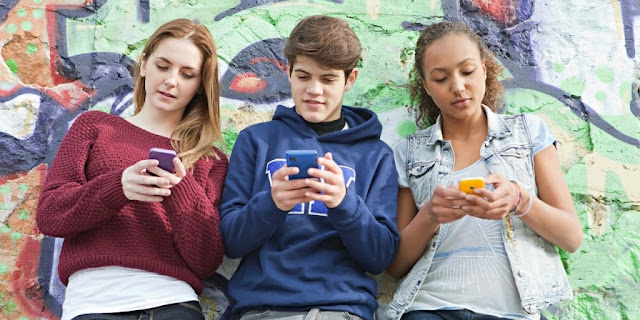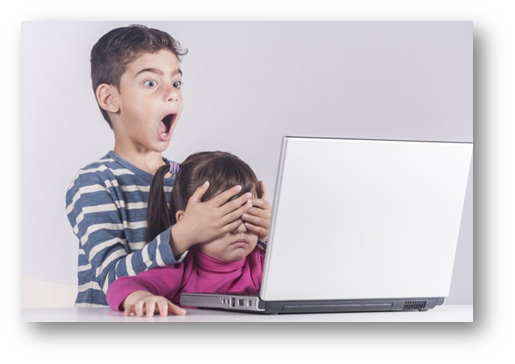Positive Social Media
Your son is turning 15 in a few weeks and approaches you about getting his driver’s permit. You hand over the keys and say, “here son, go practice with my car. I’m sure you know what to do.” That seems like the logical thing to do, right? Of course not. That would be quite foolish to expect an inexperienced 15-year-old driver to be able to know how to balance between braking and accelerating, who has the right of way at an intersection, how to naturally merge into traffic on the freeway, or even what kind of gasoline the car needs. Parents, driver’s education teachers, and the laws of the land help teach teenagers the proper way to operate a vehicle (Simons-Morton, Ouimet, & Catalano, 2008). A smartphone is not quite the same as a car, but handing one over to your child should come with some training, education, and rules.
This blog has discussed a few of the potential risks that come from poor use of mobile media devices and social media platforms. It has been scientifically proven that there are very real consequences to excessive social media exposure. (Livingstone & Smith, 2014).
There are also many benefits with teenagers having access to social media platforms. Teenagers are more informed, have more access to educational materials, are able to strengthen their identity through different social platforms, and have more opportunities to be involved in worthy causes (Bers, 2010).
More Informed
 On
the right sidebar of Facebook there is always a list of current events.
Scrolling through the search page of Instagram can show a quick glimpse at news
highlights. YouTube offers suggestions on the side of their screen for related
content links, as well as popular videos which often include news highlights. These are just a few examples of how teenagers are staying up to date
with news headlines. The 2016 US Presidential election had a trending hashtag
on Twitter and Instagram titled “too young to vote.” Teenagers were finding a
way to have a voice about the political race over social media even though they
were too young to vote (Ergeson, 2016).
On
the right sidebar of Facebook there is always a list of current events.
Scrolling through the search page of Instagram can show a quick glimpse at news
highlights. YouTube offers suggestions on the side of their screen for related
content links, as well as popular videos which often include news highlights. These are just a few examples of how teenagers are staying up to date
with news headlines. The 2016 US Presidential election had a trending hashtag
on Twitter and Instagram titled “too young to vote.” Teenagers were finding a
way to have a voice about the political race over social media even though they
were too young to vote (Ergeson, 2016).
Social media also allows
teens to stay informed with current events in their local community. They can
become aware of school or church events (Austin, 2016). Not only can they be
informed but they can retweet, regram, or repost information to inform their
friends.
Educational Opportunities
 |
Social media is often a
distraction in class or while doing homework, but it doesn’t have to be.
A study was done using a 7th grade classroom in the US and in Turkey to
see how social media could connect these 2 classes educationally. The students
in both classes were excited about the opportunity to quickly communicate with,
learn from, and befriend these fellow students on the other side of the world
(Tuzel & Hobbs, 2017). Social media connected these classes to improve
their cross-cultural education, but educational opportunities are everywhere.
Teenagers now use social
media apps to work on group projects or for after school study sessions
(Communications Team, 2015). They use social media platforms like Facebook and
Twitter to ask research questions or create a discussion with their friends
(Austin, 2016). Teachers will use social media sites during class as a way for
students to share information on the spot or to post pictures of a project they
are working on (Hughes, 2016).
Strengthen Identity
Has your child ever
shown interest in things like internet coding, robotics, or cosmetology? You
can do a quick search on Facebook with keywords like “coding for teens” or
“robotics club” to see that there are a variety of special interest groups your
child can join online. These groups help a teenager feel included and give them
a sense of identity and purpose. Joining groups like these can also give a
child greater confidence because they are learning and participating in a field
they are interested in (Austin, 2016).
Social media allows for
greater self-expression. This new social realm gives teenagers a voice through
pictures, words, and videos; a voice they may not have had in a face-to-face
interaction. Social media offers a greater sense of unity and connection among
teenagers. Social sites are far reaching and allow teens to unite with
peers across the country or the world (Austin, 2016; Basat, 2010; Valkenburg,
Peter & Schouten, 2006).
More Involved
Opportunities
to volunteer and be more involved in their community are expanding because of
social media. (Lee & Horsley, 2017) There is a great company called Volunteer Match that links community members with local volunteer opportunities.
Companies like this are learning that a better way to reach people is by
using social media to make the matches. Instagram is full of volunteer
pages like Volunteer Match, Do Good Live Well, and even your local United Way
organization. By following these Instagram sites teenagers can see
current opportunities within their community or even volunteer opportunities
that are Internet based.
For a comprehensive list of volunteer opportunities for your children, click here.
For a comprehensive list of volunteer opportunities for your children, click here.
Closing
The
opportunities that come from positive social media use are limitless. The key
is giving your child the right guidance and education when you give them a
handheld device or allow them to access social media. Driving a car takes
practice and so does proper mobile media use. If your child seems to be
consumed with their mobile device, take the opportunity to start promoting
positive changes that can benefit them and their community (Lee & Horsley,
2017).
Challenge
- Do
you know what a hashtag is? If not, ask your teenager.
- As
a family, search out volunteer opportunities through the sites listed
above.
- Encourage
your child to find a club online that they can join
In the following video a young teenager shares 10 positive effects of social media.
References
Austin, K. (2016, June 23).
The pros and cons of social networking for teenagers: A parent's guide.
Retrieved from https://www.education.com/reference/article/pros-cons-social-networking-teenagers/
Başat, B. G. (2010). Changing
media experiences of young people in the age of the Internet. Global Media
Journal: Mediterranean Edition, 5(1/2), 40-48. Retrieved from https://eds-a-ebscohost-com.byui.idm.oclc.org/eds/pdfviewer/pdfviewer?vid=6&sid=3fc1d1cc-b4b6-476a-a6c2-e2896dafad57@sessionmgr4009
Bers, M. U. (2010). Beyond
computer literacy: Supporting youth's positive development through technology. New
Directions for Youth Development, 128, 13-23. doi: 10.1002/yd.371
Communications Team. (2015,
May 9). How social media can help students study. Retrieved from https://www.mheducation.com/blog/thought-leadership/how-social-media-can-help-students-study.html
Ergeson, A. (2016, November
6). Teens too young to vote find voice in social media. Retrieved from http://www.yakimaherald.com/unleashed/teens-too-young-to-vote-find-voice-in-social-media/article_1d9a6fe6-a3f2-11e6-90a6-2bb227d1afa8.html
Hughes, B. (2016, April 01).
How social media is reshaping today's education system. Retrieved from https://www.entrepreneur.com/article/273044#
Lee, A. R., & Horsley, J.
S. (2017). The role of social media on positive youth development: An analysis
of 4-H Facebook page and 4-H'ers' positive development. Children and Youth
Services Review, 77, 127-138. doi: 10.1016/j.childyouth.2017.04.014
Livingstone, S., & Smith,
P. K. (2014). Annual research review: Harms experienced by child users of
online and mobile technologies: The nature, prevalence and management of sexual
and aggressive risks in the digital age. Journal of Child Psychology &
Psychiatry, 55(6), 635-654. doi: 10.1111/jcpp.12197
Simons-Morton, B. G., Ouimet,
M. C., & Catalano, R. F. (2008). Parenting and the young driver problem. American
Journal of Preventive Medicine, 35(3 Suppl), S294-S303. doi:
10.1016/j.amepre.2008.06.018
Tuzel, S., & Hobbs, R.
(2017). The use of social media and popular culture to advance cross-cultural
understanding. Comunicar, 25(51). 63-72. doi:10.3916/c51-2017-06
Valkenburg, P. M., Peter, J.,
& Schouten, A. P. (2006). Friend networking sites and their relationship to
adolescents' well-being and social self-esteem. Cyberpsychology &
Behavior, 9(5), 584-590. doi:10.1089/cpb.2006.9.584






Comments
Post a Comment